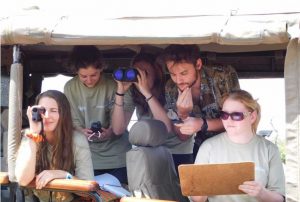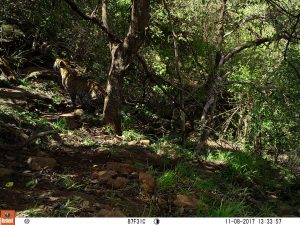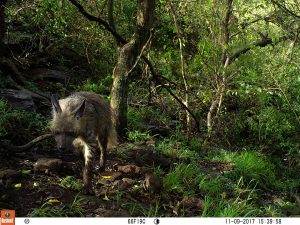This year the MRes Wildlife Conservation team ventured to the Maasai Mara for the first time for their field course module. Nobody knew what to expect and we were all amazed by the amount and variety of wildlife we encountered. During our time in the Mara we also developed a variety of skills and contributed to the conservancies we visited as much as we could in the short time we were there.
We camped out in the bush on Naboisho conservancy, a community conservancy established almost 10 years ago as an area for both wildlife and the pastoral grazing of cattle from the community. The hospitality was great and all the staff were friendly and accommodating. Many animals entered our camp, both during night and day, including baboons (Papio sp.), zebra (Equus quagga) and even hippo (Hippopotamus amphibius)!
Driving through the Mara we observed some incredible wildlife in action, including witnessing a cheetah hunting (Acinonyx jubatus), bees swarming, impala rutting (Aepyceros melampus), vultures wheeling overhead and lion cubs playing (Panthera leo). We even saw a hyenas in their den (Crocuta crocuta).
Our guides, Dickson, Senchura and Zarek, had incredible knowledge of the area and were very keen to share it with us. We learnt that the critically endangered Rüppell’s vulture (Gyps rueppelli) is the world’s highest-flying bird and has even been caught in aeroplane engines! We also learnt that Giraffes may lick the bones of dead animals to gather minerals.
From our base on Naboisho conservancy we visited Pardamat, a conservancy in the initial steps of being set-up. Both have had little research into their ecosystems, which provided us with a unique opportunity to gather baseline data on the health of the ecosystems and the levels of biodiversity. Under the guidance of our lecturers, Zeke and Martin, we carried out vegetation and soil surveys, distance sampling and camera trapping. We found that Naboisho had a good vegetation structure thanks to their well-managed grazing plan, which was reflected in the amazing amount of wildlife. Pardamat is newly-established and still mostly residential, but it has good potential to become as well-established as Naboisho!
The camera traps captured some amazing images, including one of a leopard (Panthera pardus) preparing to leap and another of a striped hyena (Hyaena hyaena)! Leopards are notoriously elusive and rarely seen in person, making the fact we captured an image of one within a few days all the more exciting. Perhaps even more exciting is the fact that the striped hyena has never been seen in Naboisho before. When we presented the image to the conservancy managers, guides and rangers, everyone was highly interested by our findings. Hopefully they will continue this work in the future to provide ongoing data about the conservancies.
While in the Mara we visited the Tony Lapham predator hub which is the base of the Mara Lion and Cheetah monitoring projects. It was extremely interesting to find out more about the current research into these charismatic animals! We also visited Mara beef, a cattle farm specialising in sustainable food production, to learn about holistic grazing methods and see the management in action.
We also had the opportunity to visit and stay in a traditional Maasai village and experience their culture. This included experiencing their singing and dancing, playing with the children, milking livestock, listening to stories around the campfire, eating traditional food, and sleeping in a Manyatta with a family. It was eye-opening to learn about their lives, how conservation must integrate with the local community and the importance of balancing the needs of humans and wildlife.
Our time in the Maasai Mara was an extremely enjoyable and unique experience that we will never forget. It has provided us with a variety of knowledge and skills that will prove invaluable in a conservation career.
Posted By : Aggie Thompson
















